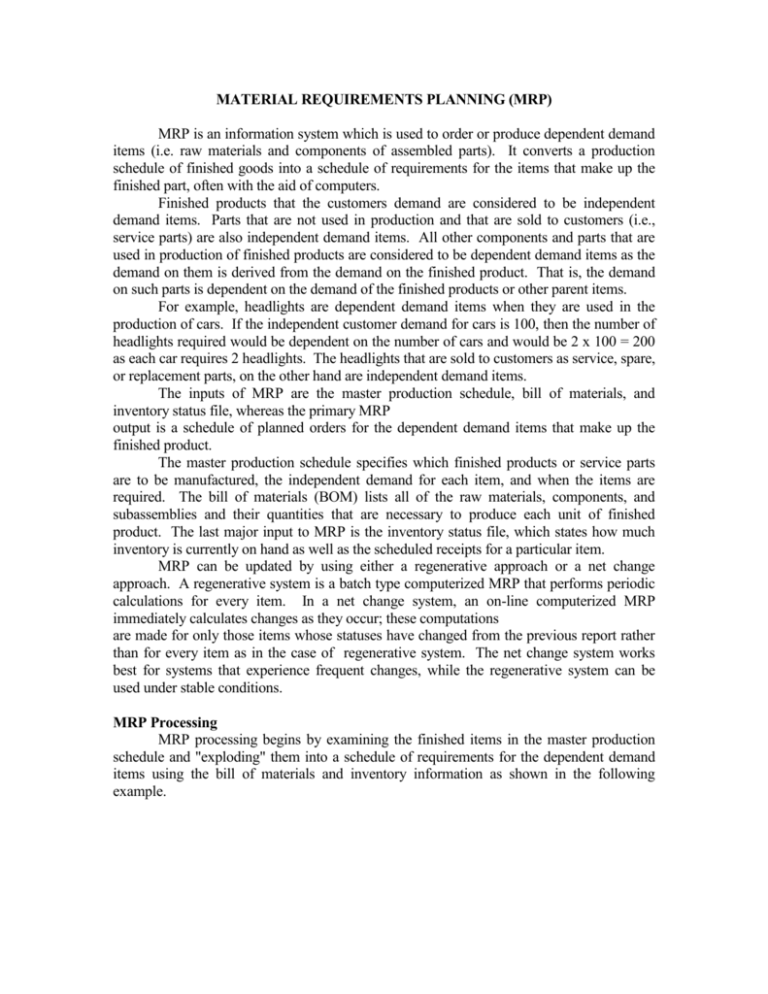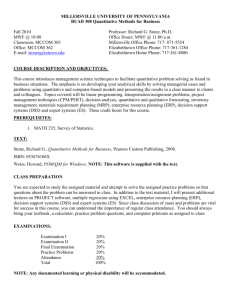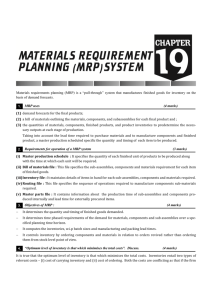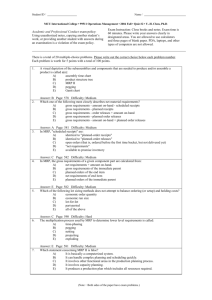MATERIAL REQUIREMENTS PLANNING (MRP)
advertisement

MATERIAL REQUIREMENTS PLANNING (MRP) MRP is an information system which is used to order or produce dependent demand items (i.e. raw materials and components of assembled parts). It converts a production schedule of finished goods into a schedule of requirements for the items that make up the finished part, often with the aid of computers. Finished products that the customers demand are considered to be independent demand items. Parts that are not used in production and that are sold to customers (i.e., service parts) are also independent demand items. All other components and parts that are used in production of finished products are considered to be dependent demand items as the demand on them is derived from the demand on the finished product. That is, the demand on such parts is dependent on the demand of the finished products or other parent items. For example, headlights are dependent demand items when they are used in the production of cars. If the independent customer demand for cars is 100, then the number of headlights required would be dependent on the number of cars and would be 2 x 100 = 200 as each car requires 2 headlights. The headlights that are sold to customers as service, spare, or replacement parts, on the other hand are independent demand items. The inputs of MRP are the master production schedule, bill of materials, and inventory status file, whereas the primary MRP output is a schedule of planned orders for the dependent demand items that make up the finished product. The master production schedule specifies which finished products or service parts are to be manufactured, the independent demand for each item, and when the items are required. The bill of materials (BOM) lists all of the raw materials, components, and subassemblies and their quantities that are necessary to produce each unit of finished product. The last major input to MRP is the inventory status file, which states how much inventory is currently on hand as well as the scheduled receipts for a particular item. MRP can be updated by using either a regenerative approach or a net change approach. A regenerative system is a batch type computerized MRP that performs periodic calculations for every item. In a net change system, an on-line computerized MRP immediately calculates changes as they occur; these computations are made for only those items whose statuses have changed from the previous report rather than for every item as in the case of regenerative system. The net change system works best for systems that experience frequent changes, while the regenerative system can be used under stable conditions. MRP Processing MRP processing begins by examining the finished items in the master production schedule and "exploding" them into a schedule of requirements for the dependent demand items using the bill of materials and inventory information as shown in the following example. Example: Based on the following master production schedule, inventory on hand, scheduled receipts, and bill of materials for the end item A, determine the size and timing of planned order releases for each of the component parts. All lead times are one week. Indep. Demand (week) 1 2 3 4 5 6 7 8 9 Inventory On Hand Scheduled Receipts (week) 1 2 3 4 5 6 7 8 9 MASTER SCHEDULE Item A B C D E 20 50 80 130 70 0 20 0 40 50 F G 20 20 20 20 20 20 20 20 20 120 20 0 50 60 30 300 30 40 Bill of Materials A ________________|_______________ | | | 2B C 3D ____|____ ____|____ | | | | 4E F 2E G Solution: PERIOD (Week) H A N D M L E V EI L T O N E EXPLOSION REPORTS: 1 2 3 4 Gross Requirements Scheduled Receipts 0 A 0 Available 0 0 30 Planned Orders 30 20 B 2A 50 80 0 0 20 80 1 2 3 Gross Requirements 80 B 20 Available 4 5 6 40 160 20 20 20 CA 2 3 Gross Requirements Scheduled Receipts 50 Available 50 50 50 0 0 130 70 7 8 9 0 0 0 230 140 230 140 5 20 80 30 0 50 D 3A HA N D 0 6 7 8 9 130 70 0 50 Planned Orders M 0 4 Net Requirements L E V EI L T O E N 0 PERIOD (Week) H A N D M L E V EI L T O N E 0 20 160 1 0 130 70 260 140 20 160 Planned Orders C 9 30 Net Requirements 1 8 130 70 Scheduled receipts 1 7 PERIOD (Week) H A N D M 6 30 Net Requirements L E V EI L T O N E 5 0 0 0 130 70 130 70 PERIOD (Week) 1 2 3 Gross Requirements 4 5 6 60 240 7 8 9 390 210 Scheduled Receipts 1 D 40 Available Net Requirements Planlanned Orders 40 40 40 0 0 20 240 20 240 0 0 0 390 210 390 210 0 PERIOD (Week) H A N D M L E V EI L T O N E E4B+2D+Ind.dem. 1 Gross Requirements 2 3 20 120 4 5 112 0 6 7 1700 980 Scheduled Receipts 2 E 50 Available 50 30 90 0 0 90 112 0 1120 FB+Ind. dem. 20 Available 940 20 40 180 20 250 160 20 20 4 5 6 7 300 0 20 0 0 20 40 120 100 40 0 0 0 0 150 160 20 20 150 160 20 20 PERIOD (Week) 2 3 4 5 6 7 8 9 0 0 20 240 120 390 210 Scheduled Receipts 60 Available 60 Planned Orders 940 20 GD+Ind.dem. Net Requirements 1700 9 H A N D L E V EI L T O N E M 0 0 8 Gross Requirements G 0 3 1 2 0 2 Net Requirements Planned Orders 1700 0 1 Scheduled receipts F 0 PERIOD (Week) H A N D M L E V EI L T O N E Planned Orders 2 9 40 Net Requirements Gross Requirements 8 40 0 0 0 0 200 120 390 210 200 120 390 210 NOTE: Planned orders don't necessarily mean planned purchase orders. It normally means planned production order unless a certain component is purchased. For example, assuming that item G is manufactured internally, we must place a production order for 200 G's in Period 3 so that they will be ready in Period 4 as the lead time is 1 period(week). Capacity Requirements MRP is very helpful in determining the capacity requirements. This concept is illustrated through the output of the previous MRP problem where the output is a schedule of planned orders. Suppose that there are no jobs currently worked on in the drilling center and only parts C, E, F, and G must go through the drilling process. Suppose part C requires 0.4 hr./unit, E requires 0.2 hr./unit, F requires 0.1 hr./unit, and G requires 0.3 hr./unit in the drilling center. Then the capacity requirements for the drilling center, in Period 3, for example would be: 0(0.4) + 1120(0.2) + 0(0.1) + 200(0.3) = 284 hrs. That means, the drilling center must have 284 hrs. of capacity available in Period 3 to process the planned orders for C, E, F, and G in Period 3 (i.e. 0, 1120, 0, and 200 respectively from the previous problem). Determining the planned orders is not sufficient; we must follow up by capacity requirements computations to check the planned orders for feasibility and see if we have enough capacity to produce the specified planned orders. In this example, if the available capacity in the drilling department is less than 284 hrs. in Period 3, we may add capacity by hiring, using overtime, adding more machines, or subcontracting or even revising the master schedule if such a revision shifts some of the planned orders to the under utilized capacity periods in a feasible way. Lot Sizing Techniques Deciding on a particular lot size to order or produce is an important issue in MRP. Unlike independent demand items where demand is typically distributed in a relatively uniform manner, demand for dependent items is usually lumpy with much shorter planning horizon. Hence, economic lot sizing is significantly more complex. With independent demand items, we usually use two lot sizing techniques; EOQ (economic order quantity) is used for ordering and EPQ (economic production quantity) is used for manufacturing. Conversely, there are many different techniques to choose from for dependent demand items. Below is a discussion on some of the lot sizing techniques for dependent demand items; Lot-for-lot (LFL), Fixed-order-quantity (FOQ), Fixed-periodrequirements (FPR), Economic-order-quantity (EOQ), and Period-order-quantity (POQ). Lot for Lot Ordering (LFL) When using LFL ordering, the lot size to order or produce is equal to the amount demanded for that particular period. Not only is this the easiest lot sizing approach to use, but it also eliminates inventory holding costs as shown in the following example. Example: Assume lead time is zero for simplicity.(Assume this for all of the lot examples that follow.) PERIOD (Month) 1 2 3 4 5 6 7 8 9 10 Net Requirements 50 20 25 0 30 25 40 15 35 45 Planned Orders 50 20 25 0 30 25 40 15 35 45 sizing 11 30 30 12 5 5 Fixed Order Quantity (FOQ) The FOQ approach specifies a fixed number of units to be ordered or produced for periods in which available inventory cannot meet the demand requirements. An example using the FOQ approach is illustrated below. Example: Order size = 50 units. Net Requirements Planned Orders 1 50 50 2 20 50 3 25 0 4 0 0 PERIOD (Month) 5 6 7 8 30 25 40 15 50 0 50 50 9 35 0 10 45 50 11 30 50 12 5 0 Fixed Period Requirements (FPR) FPR uses a varying ordering quantity that must cover the demand of a predetermined number of periods as demonstrated in the following example. Example: Assume a 4-period requirement. Net Requirements Planned Orders 1 50 95 2 20 3 25 4 0 PERIOD (Month) 5 6 7 8 9 10 30 25 40 15 35 45 110 115 11 30 12 5 Economic Order Quantity (EOQ) The EOQ model performs relatively well with independent demand items whose demands are more uniform as compared to dependent demand items. However, with dependent demand items especially at the lower levels, demand tends to be more lumpy, and therefore the EOQ approach is less appropriate. In oder to use this technique, first EOQ must be computed on the basis of demand, ordering cost, and holding cost. Then, a quantity equaling EOQ is ordered for periods in which available inventory cannot meet the demand. The difference between Fixed Order Quantity(FOQ) and Economic Order Quantity(EOQ) is that FOQ is determined subjectively based on experience whereas EOQ is determined mathematically. Example: Assume EOQ = 80 units. Net Requirements Planned Orders 1 50 80 2 20 3 25 80 4 0 PERIOD (Month) 5 6 7 8 30 25 40 15 80 9 35 10 45 80 11 30 12 5 Period Order Quantity (POQ) When using the POQ technique, an order interval(the time between each order) is computed based on the annual demand and the EOQ as demonstrated in the following example, and then, a quantity to cover the demand for the periods in that order interval is ordered. Example: Assume EOQ = 80 units, and 1 period = 1 month. Number of orders = D/Q = 320/80 = 4 Order Interval(OI) = 12 months / 4 orders = 3 months per order We could also obtain the order interval from the following formula: OI = Q/D = 80/320 = 0.25 years(1/4 years) or 3 months. Net Requirements Planned Orders 1 50 95 2 25 3 20 4 0 PERIOD (Month) 5 6 7 8 30 25 40 15 55 90 9 35 10 45 80 11 30 12 5 NOTE: Even though the planned order of 55 units would normally be under period 4, we move it to Period 5 as there is no net requirements in Period 4. MRP versus Order Point Systems Order point systems can be used with independent demand items, but they are not suitable for dependent demand items. MRP is suitable for dependent demand items. Order point is primarily concerned with how much to order when the inventory drops to a certain level whereas MRP is more concerned with when to order and time-phased requirements. Order point uses past information whereas MRP emphasizes future information and generates time-phased requirements on the basis of expected future demand over a planning horizon. When applied to parts, the order point system determines the order quantity and reorder point for a part as if that part is independent of the other parts or components comprising the same finished product. For example, if B is a part that goes into the finished product A, the inventory on hand for item A would affect how many B's are required. If the order quantity for B is determined by using order point system, the inventory on hand for the parent item A would not be taken into account and the results would be inaccurate. On the other hand, MRP considers all the parts and components comprising the product concurrently and recognizes the relationships and interdependencies between them. Therefore, using MRP for determining the requirements for dependent demand parts would be more suitable than the order point method. Also, order point systems are not appropriate if the demand is not uniform. The demand is not stable for dependent demand items and therefore the order point system would not be suitable; MRP can deal much better with lumpy demands of dependent demand items.






